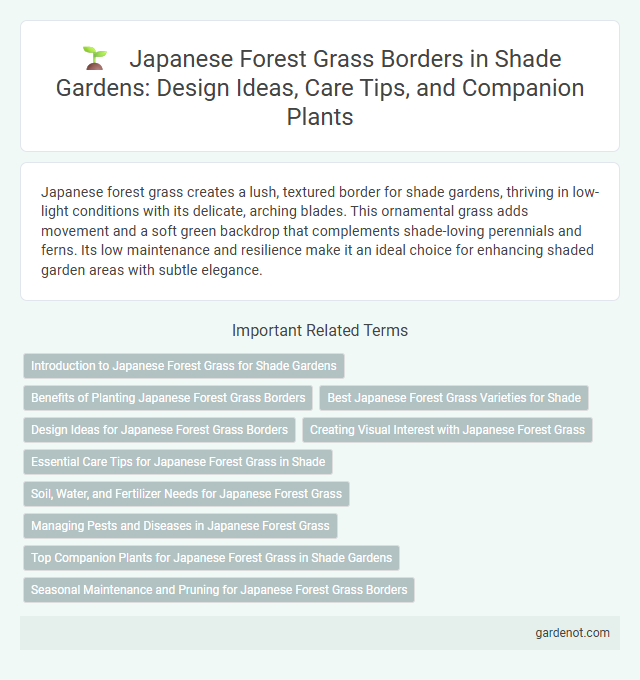Japanese forest grass creates a lush, textured border for shade gardens, thriving in low-light conditions with its delicate, arching blades. This ornamental grass adds movement and a soft green backdrop that complements shade-loving perennials and ferns. Its low maintenance and resilience make it an ideal choice for enhancing shaded garden areas with subtle elegance.
Introduction to Japanese Forest Grass for Shade Gardens
Japanese Forest Grass (Hakonechloa macra) thrives in shade gardens, offering vibrant, arching foliage that enhances low-light landscapes. Its adaptability to moist, well-drained soils and tolerance for deep shade make it an ideal groundcover or border plant in shaded areas. The natural cascading growth habit adds texture and movement, complementing woodland garden designs and shaded pathways.
Benefits of Planting Japanese Forest Grass Borders
Japanese forest grass borders offer exceptional shade tolerance, thriving under low-light conditions while enhancing garden aesthetics with their graceful, arching foliage. Their dense growth habit helps suppress weeds, reduces soil erosion, and improves soil moisture retention, making them ideal for sustainable shade garden designs. These borders also attract beneficial pollinators and provide habitat for native wildlife, contributing to biodiversity and a balanced garden ecosystem.
Best Japanese Forest Grass Varieties for Shade
Hakonechloa macra 'Aureola' stands out as a top choice for shade gardens, offering vibrant gold-striped foliage that brightens dark corners. Varieties like 'Alboa' feature graceful white-striped leaves, enhancing texture and visual interest in low-light environments. These hardy Japanese forest grasses thrive in shaded borders, providing year-round structure and subtle movement with their arching blades.
Design Ideas for Japanese Forest Grass Borders
Japanese forest grass (Hakonechloa macra) borders create a serene and flowing aesthetic with their cascading, arching foliage that softens garden edges. Pairing this native ornamental grass with shade-loving perennials like hostas and ferns enhances texture contrast while maintaining a lush, tranquil atmosphere. Incorporate curved paths or natural stone edging to complement the grass's natural movement, emphasizing an organic, harmonious garden design.
Creating Visual Interest with Japanese Forest Grass
Japanese forest grass (Hakonechloa macra) adds dynamic texture and movement to shade gardens, creating visual interest with its graceful arching leaves and vibrant green or golden hues. Its flowing form contrasts beautifully with darker foliage, enhancing depth and softness along garden borders. This low-maintenance ornamental grass thrives in partial to full shade, making it ideal for brightening dim garden corners while providing year-round structural appeal.
Essential Care Tips for Japanese Forest Grass in Shade
Japanese forest grass (Hakonechloa macra) thrives in shaded garden borders with consistent moisture and well-drained soil rich in organic matter. Regular watering ensures the foliage remains lush, while mulching helps retain soil moisture and suppress weeds. Pruning in late winter removes dead leaves, promoting healthy new growth and maintaining a tidy appearance.
Soil, Water, and Fertilizer Needs for Japanese Forest Grass
Japanese Forest Grass (Hakonechloa macra) thrives in well-drained, humus-rich soil with consistent moisture retention to support its lush growth in shade garden borders. It requires regular watering to maintain evenly moist soil but should avoid waterlogging to prevent root rot. Balanced, slow-release organic fertilizers applied in spring enhance its vibrant foliage without promoting excessive growth.
Managing Pests and Diseases in Japanese Forest Grass
Japanese forest grass (Hakonechloa macra) thrives in shaded gardens with minimal pest issues, but vigilance against slugs, snails, and aphids is essential for healthy growth. Regular inspection and removal of affected foliage help prevent infestations, while natural predators like ladybugs control aphid populations effectively. Applying organic mulches and maintaining good air circulation reduce fungal diseases such as rust and leaf spot common in humid shade environments.
Top Companion Plants for Japanese Forest Grass in Shade Gardens
Japanese Forest Grass (Hakonechloa macra) thrives in shade gardens, pairing exceptionally well with hostas, ferns, and astilbes to create lush, textured borders. These companion plants complement its arching, bamboo-like foliage with contrasting leaf shapes and colors, enhancing visual interest and depth. Incorporating shade-tolerant groundcovers like sweet woodruff or lungwort further enriches the garden's layered design and supports a healthy, moisture-retentive soil environment.
Seasonal Maintenance and Pruning for Japanese Forest Grass Borders
Japanese Forest Grass (Hakonechloa macra) thrives with seasonal maintenance, including light pruning in early spring to remove dead or damaged foliage, promoting fresh growth. Regular removal of faded leaves throughout the growing season ensures a tidy appearance and healthy plant development. In late fall, cutting back the grass to a few inches above the ground prepares the border for winter dormancy and encourages vigorous regrowth in spring.
Japanese forest grass border Infographic

 gardenot.com
gardenot.com